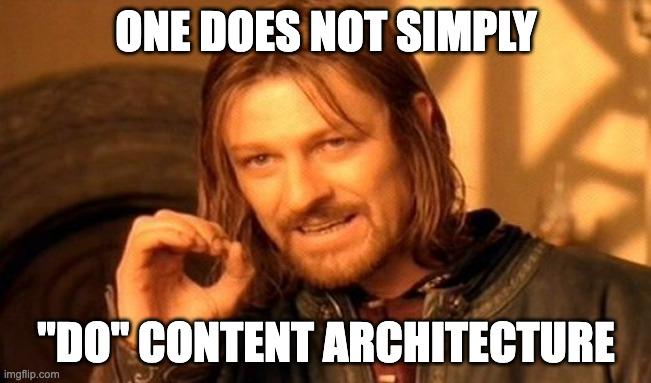Why Content Architecture Matters to Marketers

Greg Lowenthal
Team Lead, Solutions Engineering, Acquia
Marketers have been talking about content forever. The less glamorous, but infinitely important, point is establishing what differentiates content and great content. And the answer is content architecture.
Every brand needs content architecture because thoughtful content architecture, in turn, paves the way for thoughtful content. Your customers use content to answer questions and make decisions, making content an important part of CX. With good content influencing good CX, content architecture assumes a pivotal role.
We’re going to explore what content architecture is and how it’s advantageous to marketers everywhere.
What is content architecture?
| Content architecture is the logic behind content – the blueprint for whatever types of content you’ll eventually create. Content architecture is the plan behind systematically assembling content in order to promote better user experience and content scalability. |
The goal of content architecture is to design the structure, creation, editorial, and flow of content to ultimately deliver it to one or more audiences. This includes the metadata and taxonomies to better describe and categorize your content. Your content architecture is foundational in any content management process, and should be done as one of the first steps of CMS implementation.
Why is content architecture important?
This is akin to asking why blueprint models are important to a home design. Without the architectural plan, builders are just winging it — not exactly what a home buyer wants from the builders.
Similarly, your customers visit a site and peruse content for specific reasons. It’s marketers’ jobs to anticipate what those reasons are and create content to match. Before that can happen, content architecture makes sure you’ve got the right infrastructure in place to get that content out there. There are questions to ask to help get you there, too:
- How much content exists?
- How many site sections share types of content?
- How is this content organized (from both the user and internal perspectives)?
These questions (among many others) ultimately set the groundwork for content architecture by finding out what you have and how it’s presented. A closely related term to user experience is content experience. The goal of content architecture is to ensure that you’re serving the smoothest possible content experience to your users. Good content experience and good user experience often walk hand in hand.
Another bonus of clear content architecture is SEO; you want Google to understand your content, too. When both customers and search engines are able to easily navigate your content, you’re paces ahead of the game from the start.
Considerations before diving into content architecture
Because content architecture is an important part of content strategy, it’s not something to just start putting together without answering some essential questions. And, since content strategies differ per organization, this list isn’t exhaustive. Still, these are some of the must-answer questions before your content architecture foray, because:

How much content do you have?
There’s never a bad time for a content audit. Asking how much content you have might seem like a strange first question, but it’s common for content to exist without content architecture and it’s important to see how much content actually exists. This will help break down where your architectural needs are. Information architecture expert Abbey Covert says it best:
“The first step to taming any mess is to shine a light on it so you can outline its edges and depths. Once you brighten up your workspace, you can guide yourself through the complex journey of making sense of the mess.”
Getting a clear sense of the size of your content architecture job will help you see how much work needs to be done and break those needs down into manageable pieces. A common error in building content architecture is trying to do everything at the same time.
Which is why, when we do a content audit, the next step is to separate content types into groups.
How many content types do you have?
This is where the content audit comes in handy. Taking a look at your database, the number of content types can indicate content architectural problem areas, but it can also show you which areas will be easier to address and which ones will be heavier lifts.
A well-organized website should have a set intention and business need for each individual content type. This is a good strategy to take when analyzing any CMS-built website using content type structures — like Drupal. List out each content type and determine its purpose. For example, here are a few Drupal content types:
| Content Type | Purpose |
| Bio | Used for biography and contact information |
| Event | Used for event information that may need to be listed as a calendar |
| News | Used for news or press releases |
| Article | Used for a blog post |
| Custom | Used to tailor new content types to specific business needs |
Content, in this sense, is a discrete set of fields, values, and associations that describe something like an article, news, or product. An article can be described in its discrete parts:
- Title
- Author
- Authored date
- Body
- CTA field
- CTA URL
A basic example, but it shows that a content type uses building blocks — fields — that make it whole. Look at the fields for each content type your organization uses. Do they overlap? A high number of content types with overlapping purposes could indicate internal confusion as to the purpose of each type. Content types with identical fields are an opportunity for consolidation — if you can use one content type to meet several needs, that makes for a cleaner content architecture.
For example, perhaps you have separate content types with identical fields for news, press releases, and blog content. It may not be necessary to have separate content types all with the same fields; perhaps the solution is to have a single content type with a select list indicating its type. This way, your developers only need to target the select field on one content type. It’s important to understand not only the purpose of the content type, but the field structure in order to make sure you are making the best use of your content types.
Who are your content creators?
Let’s not forget about your content authors. Sure, the end goal is to create content that dazzles readers and makes their lives easier, but if it’s easier for your content creators to build better content experiences, it shines through.
Who is writing your content? How do they need to create the content they write? How do they preview the content they create? Maintaining simple but flexible interfaces for your content editorial experience will minimize any impediments to your non-technical content authors to create the content.
And, since we’re talking about content architecture for marketers, this is huge. A well-structured, easily navigable content architecture allows marketers to build, reuse, iterate, and deploy content with purpose. Say goodbye to bugging developers to help create content that you could do on your own.
Where do taxonomy and metadata come into play?
Taxonomies underpin content architecture by clearly mapping terms that classify specific content. This makes it easier for content creators to label content and easier for customers to find it. By looking at not only how many taxonomy terms exist, but how many are in use, you’ll be able to clean up terms only used a few times.
There’s also metadata. Metadata fields are usually defined as part of the content structure at the same time as the more descriptive fields. Metadata contains information about a content item that is not necessarily part of the content itself. For example, the expiration date of an article may be considered metadata. It’s used to help with search, including both internal site search as well as external search (e.g. Google, for SEO).
It is typical to mix multiple different taxonomies together with metadata to make your content as descriptive as possible. This is critical for search, navigation, and personalization. As your content numbers grow, their taxonomies and metadata become increasingly important to find and update your content while enabling your content consumers to find what they are looking for.
Unless there is an explicit business need, freeform taxonomy terms and inconsistent metadata aren’t helping your users find the content they need and can bog down your organizational system. With Drupal, you can make the most of your taxonomy terms by using them not only to organize your content but by mapping them to your metadata tags and other user-defined content, keyword, and persona fields.
If any of these factors resonate with you, you may want to rethink your content architecture. Like most SEO strategies, content should be accessible to those who need it (content creators and customers alike), when they need it, and findable by search engines. This is where a tight taxonomy strategy comes into play.
Composability is at the heart of content architecture
Do you remember Legos™? You’d buy a new Lego™ set and build it according to the instructions. Later on, you’d take it apart and those Legos would join a box with all the others. Think of a content type like a Lego™ set built according to the instructions.
Each individual block would be a piece of that Lego set. Now, the neat thing about composable content is that each of those pieces could be reused somewhere else. So, not only can you compose different content with these pieces, you can pick and choose to use any of those pieces wherever or however else they might be necessary.
It’s important to note the separation of content and presentation in a CMS, too. Modern content architecture uses this separation in such a way that when you build content in your CMS, it’s not limited to displaying via one medium — a website, for instance. You can reuse content across channels, and as we’re seeing growth in the worlds of AR, VR, IoT, mobile applications, digital signage, and beyond, this ability is increasingly powerful. Which is why content architecture plays a crucial role in pushing organized content across every channel your organization needs.
Drupal supports well-defined content architecture by allowing you to map fields and content entities (content types). For instance, the aforementioned content types are composed of different fields, but the fields can be used across different content types to allow you the flexibility to create whatever you need. Furthermore, you can create your own custom content types and fields for use cases outside of what comes in the box. Acquia Site Studio displays this power in a user-friendly interface:
The catch is, you won’t have composable content without first having content architecture that defines the content types and components! In order to be able to effectively do this, your content architecture needs to be solid. Otherwise, you’re trying to build things without clearly defined pieces.
Once you’ve defined those pieces, you’ll be able to create any content your customers might want.
What are the benefits of solid content architecture?
The benefits of content architecture work behind the scenes. Content architecture isn’t in the spotlight, because when it’s on point, it puts user experience in the spotlight. In the end, content architecture does a bunch of great things:
- Makes content creation easier
- Helps users find what they’re looking for quicker
- Organizes the back end of your website
- Scales your team’s ability to create, iterate, and deploy content
- Helps non-technical users lean less on developers
- Supports omnichannel content efforts by enabling you to repurpose content to use in multiple places
- Uses composable content to create diverse content more quickly
What’s next?
Without solid content architecture, your content won’t be as effective as it could be. The process may seem daunting, but it’s vital to building content that elevates the customer experience. You don’t have to do it all in one fell swoop, and we’re here to help.
If you’re looking to take your content to the next level, we’d love to chat about how we can help you formulate a content architecture that revitalizes your digital experiences. Content architecture is central to Drupal being a leader in the CMS world. Get in touch and we’ll show you.


